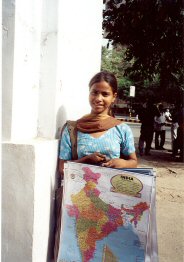India's Culture: Welcome to Delhi

Note: India's culture is part of a travel blog that I wrote during an extended business trip to India. I spent two months in New Delhi as my employer implemented a new business unit in two of its call centers. In addition to my professional work, I took time to study Hindi, an effort that fostered greater co-operation and trust among my Indian business associates. It also helped me better understand the culture. We believe that language opens a gateway to understanding culture. These pages focus on my observations and experiences in India. While I was there, I practiced Walkabout Language Learning. See the list of "More India Stories" on this page to explore how culture and language intertwine.
 Young girl selling maps at Indian market.
Young girl selling maps at Indian market. Leslie Woodford
I am at the centre in India (notice the British spelling, "centre;" while the Indians are learning to be more American, I'm trying to be more Indian). As a training manager, I will work with the local training manager and the Indian trainers and who are training the new hires in their job responsibilities. In addition to learning how to use the computers programs necessary for their jobs, they'll attend typing classes, and they'll go through a course on American culture. They are taught how to speak with American conventions, for example using the word "zee" for the last letter of the alphabet instead of the British "zed." In addition, they get some training about typical American slang.
Today, I listened as the trainers debated various American slang phrases: "going postal," "slam dunk," "I'll take a rain check." They are discussing what these phrases mean so that they can transfer the information to their culture-hungry students. It was amusing to listen to the phrases that they have picked up and to hear their interpretation of American slang.
More India Stories
- Introduction to India Blog
- Welcome to Delhi
- Holy Cow, What Happens When One Dies?
- Visit to the Market
- Traffic in India
- Call Centers in India: Am I Talking to … Myself?
- No Water? India’s Dilemma. Power Out? No Biggie
- Indian Clothing Here and There
- Indian Music: Singing Songs and Swimming Swamp
- Whatever You Do, Don’t Spoil Your Car
- Explore the Taj Mahal in a Unique Way
- Poverty in India: A little TV Tonight? Your Tarp or Mine?
- Sweet Shops
The centre is a high rise building, as modern and clean as any you'll find. Outside, a circle drive loops around a small patch of crew-cut grass. A steady supply of white Toyota Qualis stream around the circle, stop, unload call center workers arriving for their shift, and reload with workers going home for the day. (See a picture here. I didn't take this one, but it could easily have been our call center.) One of the perks of this job is free transportation to and from home. Many of the workers are young adults who do not have their own vehicles. The drive to work is an hour and half for most of them, partly because of the thick stop-and-go traffic in India.
In the grassy circle--it's just a little bit larger than my living room back home--three men work one industrial sized hand propelled lawn mower: one pulls a rope connected to the front, one pushes from behind, and I'm not sure what the other guy is doing. At least this machine isn't contributing the massive cloud of smog that hangs over the city. Besides, it gives three men a steady job. Cheap labor is India's greatest commodity. Someone commented during my stay: In India, even if you are "one-in-a-million," there are still thousands of people just like you. Job competition is fierce.
A shiny atrium greets me as you enter the building. Windows soaring several stories high let in light, and even in the heat of August, air conditioning keeps this building comfortable. The building boasts six floors, different accounts are housed on different floors. It might be American Express, or Microsoft, or some other well known American company. An elevator zips me up to my destination. It is an interesting experience riding these elevators ... I've not yet learned the customs associated with body odor in my host country. Some people smell like flowers and roses, heavy perfumes or cologne, but others are perfumed by the scent of the foods they consumed last night: curry, garlic, and spices. Some individuals are eye-wateringly sour, others musky and hot. After all, it's summer in India, the temperatures hit 40℃ (104℉) most days. Humidity hovers around 70%. Generally, I'm not a sweat-er; I have a high heat tolerance: on a warm day, I might glisten slightly, but rarely do I perspire in earnest. Here in India, even I feel the beads of sweat as they race down my back.
 The sign outside the call center cafe.
The sign outside the call center cafe. Leslie Woodford
India's Culture: the Café, Cows, Bathroom Habits
In addition to providing transportation, the call center gives each worker one hot meal a day. The café sign proclaims, "Welcome to Wimpy." I'm silently rolling on the floor laughing -- until my mom tells me that it was a well-known burger chain when she was young. Wimpy? Wimpy means "weak" in American slang. Maybe the trainers should debate the meaning of that slang word. Funny thing, words can take on a new meaning at different periods of time or in a different culture.
India's culture surprises me. Even after my other travels, I'll admit I've been astonished a few times. Before I came, many of my co-workers who'd already been here said me that cows wandered around, but in my mind, I pictured that they I figured they wandered around with a cowherd guiding them from place to place; carefully ensuring that they didn't stray into roadways or industrial areas. Nope, I've seen groups of cows or just individuals wandering around in the streets with no human guides. And guess what, they saunter into the roads frequently to munch the grass in the medians, and then they lie in the center of the roadways chewing their cud as cars nimbly weave around them. That has been eye-opening. I can't tell if anyone owns them or not. This is one part of India's culture that I must find out more about.
I’ve been surprised by seeing people using the bathroom next to the road. Grown men, peeing or squatting by the road. Not children--who we might expect didn't know better. Now that is a surprise about India's culture. The whole bathroom thing is different, too. The culture guide books say that Indians don't use toilet paper, preferring instead to spray water on themselves. Not quite sure how that works... but it means the floor is sometimes wet in the bathroom. There is a little hose in the bathrooms, or sometimes a small metal pitcher, but luckily the call center offers toilet paper in the bathrooms.
Those are my first reactions to India's culture.
--Posted by Leslie, Sunday, August 3
← Previous: Introduction to India blog
Next: Holy Cow, What Happens When One Dies? →
Return from India's Culture to Language Lore
Return to Your Language Guide home
Stay in Touch with Language Lore ezine
Want to stay in touch? Subscribe to Language Lore, our internet language learning email newsletter. This free ezine facilitates your language learning journey. See our back issues here.
Go to your email now to confirmation your subscription. If you don't see an email within an hour (check your junk mail folder too), please contact us. We respect your privacy and never sell or rent our subscriber lists. If you want to get off this list later, one click unsubscribes you.
New! Comments
Have your say about what you just read! Leave me a comment in the box below.